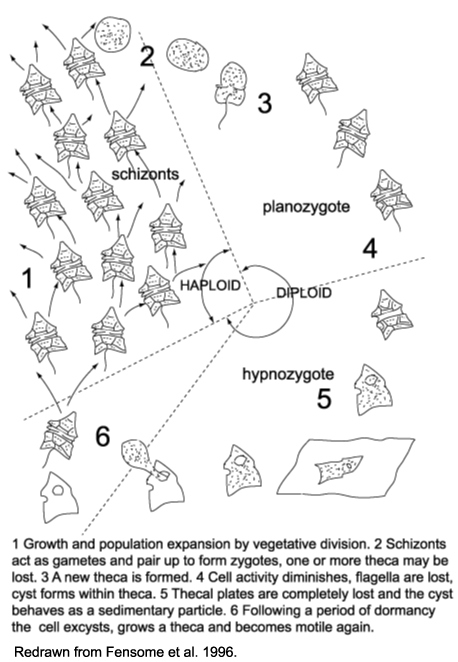Bioluminescence in Dinoflagellates
Biology 342 Fall 2010
Caitlin Miller and Madeline Dansky
Ontogeny
Ontogeny is a description of an organism's development, from the gene level to different stages of life (18)
Life Cycle:
The life cycle of dinoflagellates consists of several stages that are usually zygotic, and in which their motile stages are in haploid states (6). The size of a dinoflagellate population typically increases by individual cells undergoing asexual reproduction. However, environmental conditions can trigger gametes to form, and sexual fusion to be achieved. Although sexual fusion has not been observed as a set process in most dinoflagellates, it is expected to be more common in their natural conditions.
Image and Labeled steps below courtesy of: Olney, Matthew: UCL – London's Global University(10)

- During periods favoured by rapid growth and population expansion, vegetative fission dominates yielding motile haploid schizonts.
- At an unknown trigger, the schizonts act as gametes and pair up and fuse to form diploid zygotes. One or more theca may be lost in the process.
- The diploid zygote constructs a new theca and resumes its motility as a planozygote.
- In several species the zygote theca becomes much thicker and considerably larger than the vegetative theca. Its outline becomes less regular, the protoplast becomes granular and reddish bodies are visible within it, the activity level decreases and after as many as fifteen days the flagella are lost, the cell is then termed a hypnozygote. The protoplast shrinks pulling away from the theca and eventually one or two membranes form a new cyst wall. The thecal plates then break apart or are decayed and the completed cyst is exposed
- The hypnozygote or resting cyst then behaves as a sedimentary particle and settles to the sea floor.
- Following a period of obligate dormancy the protoplast excysts (typically through an archaeopyle), and the cycle closes as meiotic division again produces haploid, thecate, motile cells.
Gross Growth Efficiencies (GGE) and Food Concentration:
Research on the impact of several factors, including food concentration and taxonomic grouping, on the gross growth efficiencies (GGE) of protozoan and metazoan zooplankton, provided some developmental information (4). The GGE is a ratio of the number of “prey carbon” consumed to “predator carbon” (4). The data from this study showed that the GGE remained relatively constant across taxa (4). However, the most reliable relationship that was identified (by multiple regression analysis) was that the GGE was influenced by food concentration (4). This relationship is comprehensible since the dinoflagellate populations cannot grow, and cells cannot undergo ontogenic changes, without sufficient nutrition.
Ontogeny of Bioluminescence as a Behavior:
The role of light within the marine environment extends to many different processes; of which, photosynthesis and bioluminescence are only two. Dinoflagellates are unicellular organsims that require energy from sunlight in order to drive the production of simple sugars, providing the cell with chemical energy to do work.
The location of dinoflagellates in ocean levels and the execution of different chemical processes depend upon temporal cycles. Dinoflagellates logically need to be closer to the surface during the day when performing photosynthesis. Likewise, dinoflagellates would ideally not want to spend energy producing light during the day when this "signal" cannot be received. Consequently, the bioluminescent behavior of dinoflagellates occurs on a circadian basis in which dinoflagellates produce light at night.
However, the plasticity and development of this behavior is largely unknown in dinoflagellates as in many other bioluminescent organisms, and many questions remain to be answered concerning the development of bioluminescence as a behavior.
For example, while the production of light of a firefly is understood to be a mating signal, the reason for the production of light in synchrony within groups of fireflies is not clear. Understanding the potential cause for this synchronous mechanism is important for recognizing the developmental mechanisms that likely function around this behavior.
Furthermore, little is understood about the dietary source and metabolic production of the organic molecules luciferins. Are there control mechanisms for bioluminescent behaviors; are there feed back loops? If so, are these regulatory systems and variations in light production affected by population densities in dinoflagellates?
There are many more questions than answers regarding the mechanisms and complexities of dinoflagellate bioluminescent behavior and those of other bioluminescent organisms. Much still has yet to be elucidated on the interactions between this particular phenomenon and ontogenetic factors.